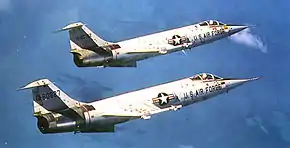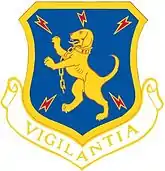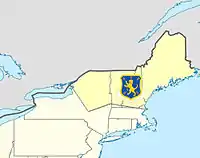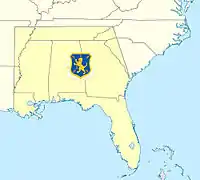32nd Air Division
The 32d Air Division (32d AD) is an inactive United States Air Force organization. It was last active with Air Defense Command, assigned to First Air Force at Gunter Air Force Base, Alabama, where it was inactivated on 31 December 1969.
| 32d Air Division | |
|---|---|
 | |
| Active | 1949–1958; 1958-1963; 1966-1969 |
| Country | United States |
| Branch | United States Air Force |
| Role | Command and Control |
| Part of | Air Defense Command |
| Insignia | |
| 32d Air Division emblem (approved 4 March 1953)[1] |  |
The division was first activated by Continental Air Command in November 1949 at Stewart Air Force Base, New York. It controlled air defense units in the northeastern United States from Stewart, and later from Hancock Field, New York until being inactivated in August 1958.
The division was activated again in November 1958 at Dobbins Air Force Base, Georgia to provide air defense of the southeastern United States, moving to Oklahoma City Air Force Station, Oklahoma in 1961. During the Cuban Missile Crisis, it was the primary air defense command for potential attacks from Cuba, acting through its Montgomery Air Defense Sector and a provisional organization at Key West Naval Air Station. The division was inactivated in September 1963.
In April 1966, the 32d was again activated at Gunter, where it replaced the Montgomery Air Defense Sector. At Gunter, it also reported to North American Air Defense Command (NORAD) as the 32d NORAD Region. It was again responsible for air defense in the Southeast until 1969, when its mission, personnel and equipment were transferred to the 20th Air Division.
History
Air Defense of the Northeast


Assigned to Air Defense Command (ADC) for most of its existence, the 32d organized, administered, equipped, trained, and prepared for operation, all of its assigned units. The division participated in exercises such as Creek Brave, Top Rung and Natchez Echo. Initially, it assumed responsibility for an area including Maine, Vermont, Massachusetts, New Hampshire, and part of New York.
Cuban Missile Crisis
During the Cuban Missile Crisis, as the division responsible for defense of the area nearest Cuba, the division role expanded. In addition to defense of its area of responsibility, the division (acting largely through its Montgomery Air Defense Sector and Task Force 32, which was established for Continental Air Defense Command and included an operating location at Key West Naval Air Station, Florida) was responsible to defend staging bases and routes to possible drop zones in Cuba for troop carrier units.[3]
Radar warning capabilities were increased. Four destroyers in the Straits of Florida, whose primary mission was to provide navigation guidance to potential strike aircraft, began to provide low altitude radar coverage as a secondary mission on 23 October, and the USS Consult was added as a picket ship. The number of Lockheed EC-121 Warning Star airborne early warning and control aircraft at McCoy Air Force Base, Florida was increased from three to six. On 24 October VAW-14 deployed six Grumman WF-2s to Jacksonville Naval Air Station. These planes moved to Key West on 26 October.[4][5]
At the same time additional interceptor aircraft were put under the division's control. Initially, the aircraft of the training wing at Tyndall Air Force Base, Florida were put on alert at Tyndall and other Florida bases, as was a detachment of VF(AW)-3 at Key West.[6] The Tyndall forces included 17 McDonnell F-101 Voodoos, 18 Convair F-106 Delta Darts and 9 Convair F-102 Delta Daggers, and were the main element in increasing the ADC alert force in Florida from 4 to 74 planes in 48 hours.[7] TF-102 trainers were placed on alert at Homestead, Patrick, McCoy, and MacDill.[8] The Navy fighter detachment was also transferred to the division's control.[6]
Twelve McDonnell F-4 Phantom IIs of VF-41 moved to augment air defense forces on Key West, and additional crews were added to the VF(AW)-3 detachment to permit it to maintain aircraft on continuous alert.[4] The 331st Fighter-Interceptor Squadron deployed 18 Delta Daggers to Homestead Air Force Base bringing the number of Deuces there to 32.[8] However, the F-102s of the 331st were soon replaced with F-102s from 325th Fighter-Interceptor Squadron in order to have planes armed with Mighty Mouse rockets[9] to improve low altitude intercept capability[10] Patrick Air Force Base, Florida received a dozen Delta Darts from the 49th Fighter-Interceptor Squadron.[8]
To improve fighter-on-fighter capability draft mobilization orders were issued for the 122d, 151st, 157th and 159th Fighter-Interceptor Squadrons, but were never finalized and the Air National Guard did not take part in the crisis.[11] The alert status of the division's fighters included airborne alert against dawn raids early in crisis.[12] The "Strategic Orbit Points" for airborne fighters were manned by 10 planes (later reduced to 4 planes).[13] Alert planes were also placed in "sling shot" status (engines running). This was later reduced to alert crews in the planes' cockpit near the runway.[12]
Army air defense forces also came under the division's control. A battery of MIM-23 Hawk missiles from the 6th Battalion, 61st Artillery was transferred from Fort Meade to defend Key West.[6][8] Homestead received a 40mm automatic weapons battery from the 1st Battalion, 59th Artillery and on 31 October. a Nike Hercules battery from the 2nd Battalion, 52nd Artillery at Fort Bliss as well as a Hawk batteries on 2 November. Hawks from the 8th Battalion, 15th Artillery at Fort Lewis were also deployed to MacDill Air Force Base and to Patrick.[8][14]
As the crisis eased, most units were released on 29 November, and except for forces retained against possible future threats from Cuba, the remaining forces were returned to their normal status by 3 December.[15]
Air defense of the Southeast

Later, beginning in 1966, the area expanded to include Mississippi, Alabama, Georgia, and parts of South Carolina, Louisiana and Florida when it assumed responsibility for the mission of the inactivated Montgomery Air Defense Sector. Assumed additional designation of 32d NORAD Region after activation of the NORAD Combat Operations Center at the Cheyenne Mountain Complex, Colorado and reporting was transferred to NORAD from ADC at Ent Air Force Base in April 1966.
Inactivated in November 1969 as ADC phased down its interceptor mission as the chances of a Soviet bomber attack on the United States seemed remote, its mission being consolidated into the 23d Air Division.
Lineage
- Established as 32d Air Division (Defense) on 8 November 1949
- Activated on 8 December 1949
- Inactivated on 1 February 1952
- Organized on 1 February 1952[16]
- Inactivated on 15 August 1958
- Redesignated 32d Air Division (SAGE) on 21 October 1958
- Activated on 15 November 1958
- Discontinued and inactivated, on 4 September 1963
- Redesignated 32d Air Division and activated on 20 January 1966 (not organized)
- Organized on 1 April 1966
- Inactivated on 31 December 1969[1]
Assignments
- First Air Force, 8 December 1949
- Eastern Air Defense Force, 1 September 1950 – 1 February 1952.
- Eastern Air Defense Force, 1 February 1952 – 15 August 1958
- Eastern Air Defense Force, 15 November 1958
- Air Defense Command, 1 August 1959 – 4 September 1963
- Air Defense Command, 20 January 1966
- Fourteenth Air Force, 1 April 1966
- First Air Force, 1 July 1968 – 31 December 1969
Stations
- Stewart Air Force Base, New York, 8 December 1949 – 12 February 1952
- Hancock Field (later Syracuse Air Force Station), New York, 12 February 1952 – 15 August 1958
- Dobbins Air Force Base, Georgia, 15 November 1958
- Oklahoma City Air Force Station, Oklahoma, 1 August 1961 – 4 September 1963
- Gunter Air Force Base, Alabama, 1 April 1966 – 31 December 1969.
Sectors
- Bangor Air Defense Sector: 8 January 1957 – 15 August 1958
- Topsham Air Force Station, Maine
- Montgomery Air Defense Sector: 15 November 1958 – 1 July 1963
- Gunter Air Force Station, Alabama
- Oklahoma City Air Defense Sector (Manual): 1 July – 1 September 1961
- Oklahoma City Air Force Station, Oklahoma[1]
- Syracuse Air Defense Sector
- Syracuse Air Force Station, New York
Wings
|
|
Groups
|
|
Interceptor squadrons
|
|
Radar squadrons
|
|
See also
References
Notes
- "Factsheet 32 Air Division". Air Force Historical Research Agency. 5 October 2007. Archived from the original on 22 October 2012. Retrieved 9 April 2014.
- Lockheed F-94C-1-LO Starfire 51-13555
- NORAD/CONAD Participation in the Cuban Missile Crisis, pp. 2, 15
- NORAD/CONAD Participation in the Cuban Missile Crisis, p. 9
- NORAD/CONAD Participation in the Cuban Missile Crisis, pp. 9–10
- NORAD/CONAD Participation in the Cuban Missile Crisis, p. 7
- McMullen, pp. 7–8
- NORAD/CONAD Participation in the Cuban Missile Crisis, p. 10
- The planes of the 331st were armed only with AIM-4 Falcons only
- NORAD/CONAD Participation in the Cuban Missile Crisis, pp. 8–9
- McMullen. pp. 15–16
- NORAD/CONAD Participation in the Cuban Missile Crisis, pp. 18–19
- NORAD/CONAD Participation in the Cuban Missile Crisis, p. 22
- NORAD/CONAD Participation in the Cuban Missile Crisis, p. 8
- NORAD/CONAD Participation in the Cuban Missile Crisis, p. 29
- The February 1952 inactivation and activation represented only a change from a table of organization unit to a table of distribution unit
Bibliography
![]() This article incorporates public domain material from the Air Force Historical Research Agency.
This article incorporates public domain material from the Air Force Historical Research Agency.
- McMullen, Richard F. (1964) "The Fighter Interceptor Force 1962-1964" ADC Historical Study No. 27, Air Defense Command, Ent Air Force Base, CO (Confidential, declassified 22 Mar 2000)
- NORAD/CONAD Participation in the Cuban Missile Crisis, Historical Reference Paper No. 8, Directorate of Command History Continental Air Defense Command, Ent AFB, CO, 1 Feb 63 (Top Secret NOFORN, declassified 9 March 1996), p. 2
- Further reading
- Winkler, David F. (1997), Searching the skies: the legacy of the United States Cold War defense radar program. Prepared for United States Air Force Headquarters Air Combat Command.
- A Handbook of Aerospace Defense Organization 1946 - 1980, by Lloyd H. Cornett and Mildred W. Johnson, Office of History, Aerospace Defense Center, Peterson Air Force Base, Colorado
- Aerospace Defense Command publication, The Interceptor, January 1979 (Volume 21, Number 1)
